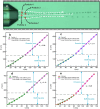Photodynamic particle pump in microfluidic systems
- PMID: 40321990
- PMCID: PMC12047725
- DOI: 10.1364/BOE.555270
Photodynamic particle pump in microfluidic systems
Abstract
Micro-pumps are widely used in biomedical equipment such as flow cytometry. In micro-flow systems, pumps are usually the main tool and means to control the flow rate of liquid. Controlling the particle movement in micro-flow is always a difficult problem in a mixed fluid of liquid and particles. In this paper, we propose a new type of photodynamic particle pump based on annular-core hollow-center fiber. The laser is coupled into the annular core by fused tapering optical fiber and welding at the cone point. A femtosecond laser processing system is used to process microscopic holes on the side of the fiber to achieve particle injection. The laser will converge to form a conical shell light field after passing through the cone, and the speed of the particles increases after passing through the conical shell light field, thus forming a particle pump. The experimental results show that the particle velocity increases with the increase of laser power at low injection pressure. In the case of constant power, the flow rate is independent of the injection pressure, and the particle velocity in the micro-flow system is controlled. It has important value and application prospects for particle acceleration control of microfluidic chip systems and cell manipulation and sorting in the microbiological field.
© 2025 Optica Publishing Group.
Conflict of interest statement
The authors declare no conflicts of interest.
Figures








Similar articles
-
A microfluidic-based hydrodynamic trap for single particles.J Vis Exp. 2011 Jan 21;(47):2517. doi: 10.3791/2517. J Vis Exp. 2011. PMID: 21304467 Free PMC article.
-
High throughput single-cell and multiple-cell micro-encapsulation.J Vis Exp. 2012 Jun 15;(64):e4096. doi: 10.3791/4096. J Vis Exp. 2012. PMID: 22733254 Free PMC article.
-
Surface Cleanliness Maintenance with Laminar Flow Based on the Characteristics of Laser-Induced Sputtering Particles in High-Power Laser Systems.Micromachines (Basel). 2023 Mar 4;14(3):598. doi: 10.3390/mi14030598. Micromachines (Basel). 2023. PMID: 36985007 Free PMC article.
-
[Research advances in nano liquid chromatography instrumentation].Se Pu. 2021 Oct;39(10):1065-1076. doi: 10.3724/SP.J.1123.2021.06017. Se Pu. 2021. PMID: 34505428 Free PMC article. Review. Chinese.
-
Methods for counting particles in microfluidic applications.Microfluid Nanofluidics. 2009;7(6):739. doi: 10.1007/s10404-009-0493-7. Epub 2009 Aug 20. Microfluid Nanofluidics. 2009. PMID: 32214956 Free PMC article. Review.
References
-
- Lashkaripour A., Silva R., Densmore D., “Desktop micromilled microfluidics,” Microfluid. Nanofluid. 22(3), 31 (2018).10.1007/s10404-018-2048-2 - DOI
-
- Gao Y., Wu M., Lin Y., et al. , “Acoustic bubble-based bidirectional micropump,” Microfluid. Nanofluid. 24(4), 29 (2020).10.1007/s10404-020-02334-6 - DOI
-
- Ikeda M., Imai S., “Basic study of micro-pumps for medication driven by chemical reactions,” IEICE Trans. Electron. 106(6), 253–257 (2023).10.1587/transele.2022OMS0007 - DOI
-
- Revathi S., Padmanabhan R., “Design and development of piezoelectric composite-based micropump,” J. Microelectromech. Syst. 27(6), 1105–1113 (2018).10.1109/JMEMS.2018.2870949 - DOI
Associated data
LinkOut - more resources
Full Text Sources
